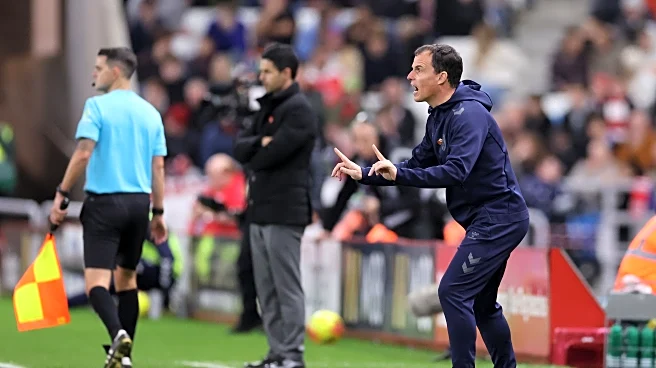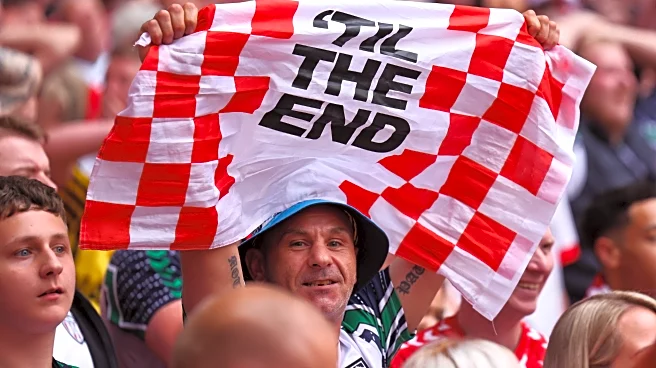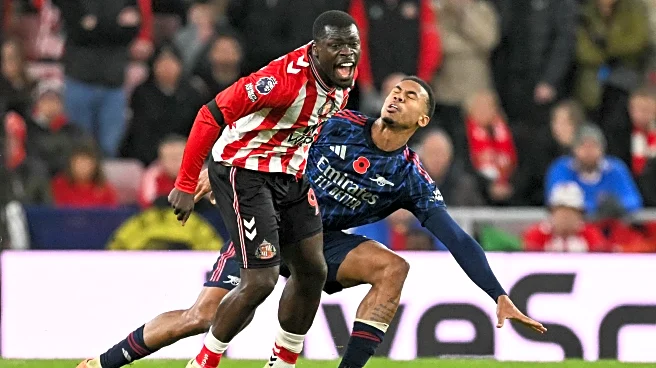Sunderland were able to remain unbeaten during their recent home double-header. Facing Everton and Arsenal within the space of a week and following some courageous efforts, we managed to scrape through
with two additional points on the board.
On Saturday Night Football, Régis Le Bris proved his worth by overseeing a tactically astute performance, putting an Arsenal team whom most would consider title favourites to the sword and breaching a defence that had won straight nine games without conceding in over 812 minutes of open play.
How did Le Bris utilise a combination of pressing zones and resolute defending to hold the league leaders and retain our unbeaten at home record over the international break?
Sunderland lineup
In a somewhat surprising move, Le Bris named an unchanged side for the third game in a row as the Lads looked to take on the league leaders after having become synonymous with making small tweaks game by game.
Sunderland continued to operate in their new-look iteration of Le Bris’ traditional 4-3-3 formation, but with the added twist of Trai Hume’s dynamic positioning — which was first showcased away at Stamford Bridge.
Capable of shifting between a 4-3-3 and a 5-4-1 in the blink of an eye, Sunderland are able to press aggressively and funnel opposition patterns of play whilst seamlessly dropping into a compact low block to defend like warriors.
Enzo Le Fée & Bertrand Traoré manned the wings whilst Hume and Noah Sadiki provided the zonal coverage around Granit Xhaka. Dan Ballard and Lutsharel Geertruida were both given man-to-man assignments due to Arsenal’s lack of a focal point, however, we’ll touch more on shape later.

Arsenal lineup
Having travelled to Prague for their midweek Champions League tie, Arsenal attempted to manage minutes and split their squad wherever possible. However, due to a lengthening list of injuries, some players weren’t given a break.
With that in mind, Mikel Arteta made just one change from the side who cruised past Burnley a week ago, with the injured Viktor Gyökeres — whom Sunderland fans know all too well — replaced by ex-Newcastle loanee Mikel Merino, who’s been a capable hand as a stand-in “false-nine” when required.
Stylistically, Arsenal retain a rigid 4-2-3-1 system which relies on disciplined positioning from the back five in order to allow the midfield and attack to control games within the opposition half. With two aggressive fullbacks in Riccardo Calafiori and Jurrien Timber, they’re able to pin opposition wingers in their own half and essentially shift into a 2-4-4 shape whilst on the front foot.
With the talent of Leandro Trossard annd Bukayo Saka out wide, Arsenal are able to carve open sides who sit deeply, with their ability to create triangles and overloads via one-touch passing and punish even the best of sides. Having not conceded in over 800 minutes of football, their defensive stalwarts had allowed an xG against of only 5.82, prior to the Sunderland match.

Sunderland win their battles — collectively and individually
In a game of fine margins, Arsenal have become the masters of utilising physicality to their advantage in recent seasons, and have been dubbed the “Set Piece Kings” due to their ability to coordinate and punish opposition teams from dead balls.
Leading the league in corners with seventy five, Arsenal utilise a variety of routines in order to unlock defensive structures, yet Sunderland were able to match them.
Ballard will take the plaudits for his fantastic all-round display but Sunderland were able to win their individual battles from the opening whistle, racking up a dizzying fifty duels during the match — including matching Arsenal on the ground with twenty nine wins, which was the same total as the opposition.
Nordi Mukiele was impeccable in the air, winning 7/7 aerial duels and finishing the game 9/11 overall, and Geertruida rounded off Sunderland’s defensive heroics with 5/7 duels won. This meant that Sunderland’s central defenders ended the game one shy of forty clearances.
In midfield, Xhaka won 80% of his duels and finished 5/6 for the game. Sadiki was 2/3 and Hume — in his hybrid role — finished with an 86% ground duel success rate, which showcased his desire and passion to compete for every ball.
Arsenal have been largely unmatched in their ability to overpower opposition sides and looked shellshocked that a team was able to match them physically throughout this one.

A first half masterclass
With a clear and defined gameplan, Sunderland produced easily their most complete forty five minutes of the season, and a combination of exceptional discipline and perfect execution allowed us to head into the break with a lead to protect.
Wilson Isidor’s ability to relieve pressure bought Sunderland a free kick which Robin Roefs punted forward, before Mukiele provided a perfectly cushioned header for Ballard to touch and volley into the roof of the net like an elite European forward.
Breaching Arsenal’s defence in the first half is no mean feat and the taste grew ever sweeter as chants of “Set Piece Again! Olé, Olé!” rang out from the away end every time Arsenal attempted one of their own.

Organisationally, Sunderland were able to pounce on every loose ball and challenge every heavy touch, leading Arsenal to look rattled within build-up.
With Hume sliding into a defensive five, we were able to double up on Arsenal’s wide players and force the wing backs to advance beyond the attacking line in order to spread Sunderland’s compact block.

One thing worth noting is Le Bris’ continued overseeing of play being funneled down the channels and teasing opponents to cross the ball, knowing that he has confidence in his defenders to deal with the cross when it finally arrives.
Arsenal attempted twenty one crosses with an accuracy rating of just 18%. This was well below their usual league average on more attempts per game and without a focal point to attack, it made Sunderland’s life easy — it was simply pouncing on the second contact that Arsenal were relying on.
A second-half swing
Arsenal cranked up the pressure during the second half and increased the intensity of their passing, but also tried to underlap with their full backs to create more chaos within the Sunderland penalty area. Indeed, the equaliser came from a mistake from Le Fée and his hesitancy to release the ball following our usual build-up.
Whilst fans may criticise Roefs for making the pass, this phase of play is one we often replicate in games through Xhaka. Le Fée will know he was coached to play a bounce pass back to his goalkeeper in that moment and he’ll be quick to dust himself off, but against top opposition — especially a pressing Declan Rice — they’ll punish you for any mistakes you make.

Interestingly, Sunderland’s shift to prevent Arsenal’s full backs from impacting the game was quite clever as Calafiori was essentially ignored by our defensive line until he hit the six yard line. He was then zonally engaged — only for our defenders to drop off again and not follow him out.
As can be seen from the images below, we step out to engage only when he enters our zonal space, only to drop off and not track beyond this.

Sunderland go ‘til the end once again!
A phrase which typifies the last six months and began at Hillsborough in League One.
Despite a hammer blow from Leandro Trossard, Sunderland were able to push Arsenal back (albeit the game state had changed and they were comfortable to trust their defence) and grab a heroic equaliser from Brian Brobbey, who scoring his first league goal of the season.
In a move which demonstrated extreme patience and maturity not to pull the trigger, Sunderland completed over a dozen passes in the sequence that lead up to Hume’s reverse ball into the box and showcased an understanding that working an angle for a Ballard mismatch against Martin Zubimendi was all we needed to win the first contact.
Brobbey’s extreme athleticism and strength to hold off Gabriel and gamble on the second phase of play mustn’t go unnoticed, as despite only coming from an xG of 0.11, the hesitancy of David Raya made the goal a foregone conclusion and just like that, the best defence in the league had been breached — not once, but twice.

The shape and the system
Le Bris continues to baffle the Premier League analysts via his unique hybrid of zonal and man-to-man pressing, and he was no different against Arsenal.
Both of Sunderland’s central defenders were given man-to-man marking jobs, with Ballard taking on Eberechi Eze and Geertruida shadowing Merino. Interestingly, Le Bris has immense trust in his players to take one vs one matchups across the pitch, allowing his players the opportunity to win their individual duels whilst in a mid-block before switching to a zonal system once we settle into our shape.
Arsenal’s wingers were often found one vs one, with Mukiele and Reinildo in the middle third of the pitch. However, once we shifted to our customary back five, it allowed us to double up on either flank and revert to a more zonal system — as seen in the image below, which demonstrated how we handled Calafiori’s underlapping runs into the box.

The momentum continues to build!
With an international break now underway, Sunderland have emerged from a bruising three-game stretch unbeaten, with a five point haul and probably having exceeded nearly everyone’s expectations whilst retaining their place in the top four.
With Omar Alderete and Romaine Mundle due back and Habib Diarra not far behind, we’ll be looking to attack our next mini-block of fixtures to build towards that magic forty point mark — which culminates in the small matter of a Wear Tyne Derby.













